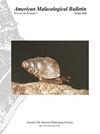分支鳃亚门的系统学、系统发育和进化研究(腹足目:异鳃亚门)。
IF 0.4
4区 生物学
Q4 MARINE & FRESHWATER BIOLOGY
引用次数: 13
摘要
摘要:枝鳃亚目是裸鳃腹足类的一个多样化分支,有约1000种沿海(底栖)和近海(远洋)海洋物种。它们的多样性可能与饮食的特殊性和动物中罕见的显著适应的进化有关,例如刺线虫的隔离。由于枝叉亚门和软体动物门内其他高阶分类群之间的深刻分歧,基于形态学或少数基因的系统发育分析无法在高支持率下解决这些分支内的关系。然而,高通量测序技术的引入为收集大型基因组数据集提供了机会,这些数据集已被证明在解决软体动物内部的关系方面很有用,就像在其他后生动物群体中一样。随着测序成本的降低,收集越来越大的数据集变得越来越容易,以试图解决最近分化的群体内的关系,如分支杆菌。分支杆菌内三个主要类群(Arminida、Dendronotida和Aeolidida)的门和关系一直很难确定,主要是由于传统分子系统发育研究中分析的mtDNA和rDNA基因的快速进化。在这篇综述中,我从形态学数据、一个或几个基因的分子分析以及基因组数据的影响等方面讨论了分支杆菌的系统学。然后,我认为,高通量测序数据提供的系统发育假说将为研究分支杆菌的分类学和特征进化提供更好的框架,因为这些数据为分支杆菌本身及其嵌套的子支提供了强有力的支持。尽管重要的是要注意,基因组数据仍然需要更广泛的分类单元采样,但很明显,利用这些数据提供了迄今为止最受支持的分支杆菌系统发育假说。在这样做的过程中,这些基因组数据挑战了已建立的关系,包括Facelinidae的单系性和Tritonidae在Dendronotida中的包含,并解决了传统上很难定位的分类群的位置,包括Melibe Rang,1829以及Proctonotidae和Dironidae科。最后,这些基因组数据为研究分支杆菌内的特征进化提供了一个更强的系统发育框架,包括该分支中的典型特征之一线虫囊隔离的进化。本文章由计算机程序翻译,如有差异,请以英文原文为准。
Insights into the Systematics, Phylogeny, and Evolution of Cladobranchia (Gastropoda: Heterobranchia).
Abstract: Cladobranchia is a diverse clade of nudibranch gastropods, with ∼1,000 coastal (benthic) and off shore (pelagic) marine species. Their diversity may be tied to dietary specialization and the evolution of remarkable adaptations that are rare among animals, such as the sequestration of cnidarian nematocysts. Due to the deep divergences within Cladobranchia, and other higher-order taxa within Mollusca, phylogenetic analyses based on morphology or a few genes have been unable to resolve relationships within these clades with high support. The introduction of high-throughput sequencing technologies, however, has provided the opportunity to collect large genomic data sets, which have proven useful in resolving relationships within molluscs, as in other metazoan groups. As sequencing costs decrease, it has become easier to collect ever larger data sets in an attempt to resolve relationships within more recently diverged groups, such as Cladobranchia. The phyly and relationships of the three main groups within Cladobranchia (Arminida, Dendronotida, and Aeolidida) have been difficult to determine, primarily due to the rapid evolution of mtDNA and rDNA genes analyzed in traditional molecular phylogenetic studies. In this review, I discuss the systematics of Cladobranchia in regards to morphological data, molecular analyses with one or a few genes, and address the impact of genomic data. I then contend that the supported phylogenetic hypotheses provided by high-throughput sequencing data will provide a better framework for studying taxonomy and character evolution within Cladobranchia, as these data provide strong support for Cladobranchia itself, as well as the nested subclades within it. Although it is important to note that a broader taxon sampling is still needed for genomic data, it is clear that utilizing these data has provided the most-well-supported phylogenetic hypotheses of Cladobranchia to date. In doing so, these genomic data have challenged well-established relationships, including the monophyly of Facelinidae and inclusion of Tritoniidae in Dendronotida, and resolved the position of taxa that have been traditionally quite difficult to place, including Melibe Rang, 1829 and the families Proctonotidae and Dironidae. Finally, these genomic data provide a much stronger phylogenetic framework for studying character evolution within Cladobranchia, including the evolution of nematocyst sequestration, one of the quintessential characters in this clade.
求助全文
通过发布文献求助,成功后即可免费获取论文全文。
去求助
来源期刊
CiteScore
1.00
自引率
40.00%
发文量
1
审稿时长
>12 weeks
期刊介绍:
The American Malacological Bulletin serves as an outlet for reporting notable contributions in malacological research. Manuscripts concerning any aspect of original, unpublished research,important short reports, and detailed reviews dealing with molluscs will be considered for publication. Recent issues have included AMS symposia, independent papers, research notes,and book reviews. All published research articles in this journal have undergone rigorous peer review, based on initial editor screening and anonymous reviewing by independent expertreferees. AMS symposium papers have undergone peer review by symposium organizer, symposium participants, and independent referees.

 求助内容:
求助内容: 应助结果提醒方式:
应助结果提醒方式:


